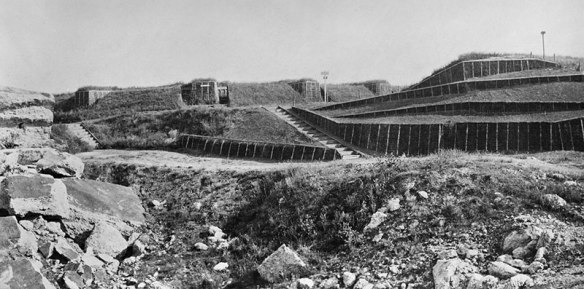Fort Loncin, near Liege, destroyed by 42cm howitzers during the advance through Belgium.
Western Europe was a beehive of activity in August 1914. France mobilized 78 infantry and 10 cavalry divisions for the heroic charge into the “martyred provinces” of Alsace- Lorraine. These “pioneers in the great war of revenge,” as Chief of Staff General Joseph Joffre called them, under Plan XVII were then to sally into central Germany and, hopefully, to link up with the Russians in Berlin. The Germans, for their part, mobilized 76 infantry and 10 cavalry divisions. Under the Schlieffen Plan, in 40 days they were to sweep through Belgium, cut in behind Paris, and drive the enemy onto the “anvil” of the German Sixth and Seventh armies anchored in Alsace-Lorraine. Nearly seven-eighths of the German army was deployed in the West. Neutral Belgium mobilized 117,000 soldiers to make a stand at and behind two of the main fortified cities, Liege (12 forts) and Namur (9 forts). Finally, about 100,000 professionals and reservists of the British Expeditionary Force (BEF) landed on the Continent – and counted on the French to find an area of deployment for them.
The spear of the attack-force consisted of General Alexander von Kluck’s First Army (320,000 men) and General Karl von Bülow’s Second Army (260,000 men). It was an incredible sight: each army corps of more than 30,000 soldiers stretched about 30 km; each munitions train 20 km; and each baggage train another 6 km. This gigantic force of nearly 600,000 men and their horses and equipment had to drive through the narrow defile of Aachen, the Ardennes, and the Maastricht Appendix by August 17-18, and then to fan out to Antwerp, en route to Paris. Immediately, the Germans came hard up against the concrete and steel forts of Liege. The job of storming Europe’s greatest defensive barrier fell to General Otto von Emmich’s special task force of 39,000 soldiers from the Second Army.
Again, the hard realities of modern industrialized warfare dictated the battlefield. A series of daring night attacks on August 5 and 6 failed to take the main fortress. Cavalry and infantry were useless against concrete and steel.
The first attempt to bomb was by the Zeppelin Z VI on 5th or 6th of August 1914, an attempted attack on the Liege Fortress. The Zeppelin descended through cloud to 5200Ft, was shot full of holes and turned back, crash landing later. It carried 8 heavy artillery shells. The French followed a few days later (14th) with an unsuccessful attack on the airship hangar at Metz.
Even Krupp’s 28-cm howitzers failed to reduce the forts. Five of the six attacking brigades were forced to retreat to their original positions. The Schlieffen Plan was in danger of falling behind schedule. In desperation, the Germans hauled four batteries of Austrian Skoda 30.5-cm howitzers up to Liege to systematically reduce the steel cupolas of the forts’ gun turrets. On August 8 the Supreme Army Command threw 60,000 more soldiers into the fight. General Erich Ludendorff took command of the 14th Brigade and stormed the inner city after a bitter all-night battle. The entire fortress complex surrendered ten days later. Namur fell on August 23. Whereas Alfred von Schlieffen had planned for a single division to take Liege and Namur, in 1914 it took eight divisions to reduce Liege alone. More than 5,400 German casualties attested to the bitter fight for the forts. The First and Second armies thereupon passed through the Liege corridor and headed west and southwest for Mons, Péronne, Compiegne, and Paris. The Schlieffen Plan seemed back on track.
